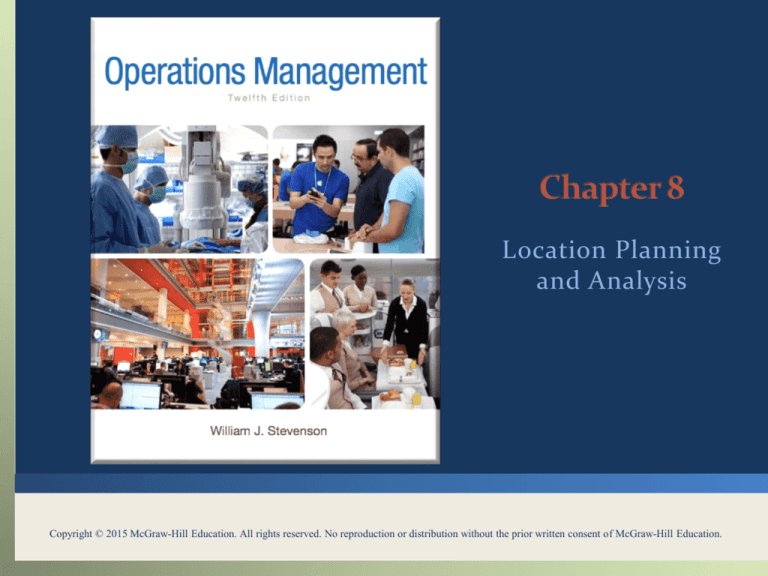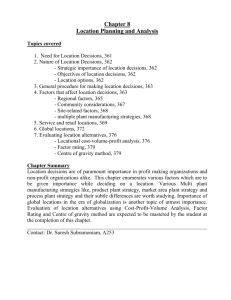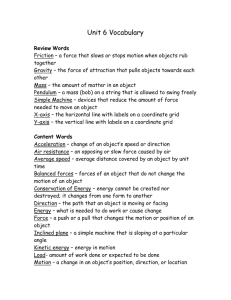
Location Planning
and Analysis
Copyright © 2015 McGraw-Hill Education. All rights reserved. No reproduction or distribution without the prior written consent of McGraw-Hill Education.
You should be able to:
LO 8.1 Identify some of the main reasons organizations need to
make location decisions
LO 8.2 Explain why location decisions are important
LO 8.3 Discuss the options that are available for location
decisions
LO 8.4 Give examples of the major factors that affect location
decisions
LO 8.5 Outline the decision process for making these kinds of
decisions
LO 8.6 Use the techniques presented to solve typical problems
8-2
Location decisions arise for a variety of reasons:
Addition of new facilities
As part of a marketing strategy to expand markets
Growth in demand that cannot be satisfied by expanding
existing facilities
Depletion of basic inputs requires relocation
Shift in markets
Cost of doing business at a particular location makes
relocation attractive
LO 8.1
8-3
Location decisions:
Are closely tied to an organization’s strategies
Low-cost
Convenience to attract market share
Effect capacity and flexibility
Represent a long-term commitment of resources
Effect investment requirements, operating costs, revenues, and operations
Impact competitive advantage
Importance to supply chains
LO 8.2
8-4
Location decisions are based on:
Profit potential or cost and customer service
Finding a number of acceptable locations from which to choose
Position in the supply chain
End: accessibility, consumer demographics, traffic patterns, and local customs
are important
Middle: locate near suppliers or markets
Beginning: locate near the source of raw materials
Web-based retail organizations are effectively location independent
8-5
Supply chain management must address supply chain
configuration:
Number and location of suppliers, production facilities,
warehouses and distribution centers
Centralized vs. decentralized distribution
The importance of such decisions is underscored by their
reflection of the basic strategy for accessing customer
markets
8-6
Existing companies generally have four options
available in location planning:
1.
2.
3.
4.
LO 8.3
Expand an existing facility
Add new locations while retaining existing facilities
Shut down one location and move to another
Do nothing
8-7
Two key factors have contributed to the attractiveness
of globalization:
Trade Agreements such as
North American Free Trade Agreement (NAFTA)
General Agreement on Tariffs and Trade (GATT)
U.S.-China Trade Relations Act
EU and WTO efforts to facilitate trade
Technology
Advances in communication and information technology
LO 8.3
8-8
A wide range of benefits have accrued to organizations
that have globalized operations:
Markets
Cost savings
Legal and regulatory
Financial
Other
LO 8.4
8-9
There are a number of disadvantages that may
arise when locating globally:
Transportation costs
Security costs
Unskilled labor
Import restrictions
Criticism for locating out-of-country
LO 8.4
8-10
Organizations locating globally should be aware
of potential risk factors related to:
Political instability and unrest
Terrorism
Economic instability
Legal regulation
Ethical considerations
Cultural differences
LO 8.4
8-11
Managerial implications for global operations:
Language and cultural differences
Risk of miscommunication
Development of trust
Different management styles
Corruption and bribery
Increased travel (and related) costs
Challenges associated with managing far-flung operations
Level of technology and resistance to technological change
Domestic personnel may resist locating, even temporarily
LO 8.4
8-12
Steps:
1.
Decide on the criteria to use for evaluating location alternatives
2. Identify important factors, such as location of markets or raw
materials
3. Develop location alternatives
a. Identify the country or countries for location
b. Identify the general region for location
c. Identify a small number of community alternatives
d. Identify the site alternatives among the community
alternatives
4. Evaluate the alternatives and make a decision
LO 8.5
8-13
Factors relating to foreign locations
Government
a.
a.
LO 8.5
Policies on foreign ownership of production facilities
Local content requirements
Import restrictions
Currency restrictions
Environment regulations
Local product standards
Liability laws
Stability issues
Cultural differences
Living circumstances for foreign workers and their dependents
Ways of doing business
Religious holidays/traditions
Customer preferences
Possible “buy locally” sentiment
Labor
Level of training and education of workers
Work ethic
Wage rates
Possible regulations limiting the number of foreign employees
Language differences
Resources
Availability and quality of raw materials, energy, transportation
infrastructure
Financial
Financial incentives, tax rates, inflation rates, interest rates
Technological
Rate of technological change, rate of innovations
Market
Market potential, competition
Safety
Crime, terrorism threat
8-14
Primary regional factors:
Location of raw materials
Necessity
Perishability
Transportation costs
Location of markets
As part of a profit-oriented company’s competitive strategy
So not-for-profits can meet the needs of their service users
Distribution costs and perishability
LO 8.5
8-15
Labor factors
Cost of labor
Availability of suitably skilled workers
Wage rates in the area
Labor productivity
Attitudes toward work
Whether unions pose a serious potential problem
Other factors
Climate and taxes may play an important role in location
decisions
LO 8.5
8-16
Many communities actively attempt to attract new
businesses they perceive to be a good fit for the community
Businesses also actively seek attractive communities based
on such factors such as:
Quality of life
Services
Attitudes
Taxes
Environmental regulations
Utilities
Development support
LO 8.5
8-17
Primary site location considerations are
Land
Transportation
Zoning
Other restrictions
LO 8.5
8-18
Organizing operations
Product plant strategy
Entire products or product lines are produced in separate
plants, and each plant usually supplies the entire domestic
market
Market area plant strategy
Plants are designated to serve a particular geographic
segment of the market
Plants produce most, if not all, of a company’s products
LO 8.5
8-19
Organizing operations
Process plant strategy
Different plants focus on different aspects of a process
automobile manufacturers – engine plant, body stamping plant,
etc.
Coordination across the system becomes a significant issue
General-purpose plant strategy
Plants are flexible and capable of handling a range of
products
LO 8.5
8-20
GIS
A computer-based tool for collecting, storing, retrieving,
and displaying demographic data on maps
Aids decision makers in
Targeting market segments
Identifying locations relative to their market potential
Planning distribution networks
Portraying relevant information on a map makes it
easier for decision makers to understand
LO 8.5
8-21
Considerations:
Nearness to raw materials is not usually a consideration
Customer access is a
Prime consideration for some: restaurants, hotels, etc.
Not an important consideration for others: service call
centers, etc.
Tend to be profit or revenue driven, and so are
Concerned with demographics, competition, traffic volume
patterns, and convenience
Clustering
Similar types of businesses locate near one another
LO 8.5
8-22
Common techniques:
Locational cost-volume-profit analysis
Factor rating
Transportation model
Center of gravity method
LO 8.6
8-23
Locational Cost-Profit-Volume Analysis
Technique for evaluating location choices in economic terms
Steps:
1.
Determine the fixed and variable costs for each alternative
2. Plot the total-cost lines for all alternatives on the same graph
3. Determine the location that will have the lowest total cost (or
highest profit) for the expected level of output
LO 8.6
8-24
Assumptions
Fixed costs are constant for the range of probable
output
2. Variable costs are linear for the range of probable
output
3. The required level of output can be closely estimated
4. Only one product is involved
1.
LO 8.6
8-25
For a cost analysis, compute the total cost for each
alternative location:
Total Cost FC v Q
where
FC Fixed cost
v Variable cost per unit
Q Quantity or volume of output
LO 8.6
8-26
Fixed and variable costs for four potential plant
locations are shown below:
LO 8.6
Location
Fixed Cost
per Year
Variable Cost
per Unit
A
$250,000
$11
B
$100,000
$30
C
$150,000
$20
D
$200,000
$35
8-27
Plot of Location Total Costs
LO 8.6
8-28
Range approximations
B Superior (up to 4,999 units)
C Superior (>5,000 to 11,111 units)
A superior (11,112 units and up)
LO 8.6
Total Cost of C Total Cost of B
150,000 20Q 100,000 30Q
50,000 10Q
Q 5,000
Total Cost of A Total Cost of C
250,000 11Q 150,000 20Q
100,000 9Q
Q 11,111.11
8-29
Factor Rating
General approach to evaluating locations that includes quantitative
and qualitative inputs
Procedure:
1.
2.
Determine which factors are relevant
Assign a weight to each factor that indicates its relative importance
compared with all other factors.
Weights typically sum to 1.00
3.
4.
5.
6.
LO 8.6
Decide on a common scale for all factors, and set a minimum acceptable
score if necessary
Score each location alternative
Multiply the factor weight by the score for each factor, and sum the results
for each location alternative
Choose the alternative that has the highest composite score, unless it fails
to meet the minimum acceptable score
8-30
A photo-processing company intends to open a new branch store. The
following table contains information on two potential locations. Which is
better?
Scores
(Out of 100)
Factor
Weight
Alt 1
Alt 2
Proximity to
existing source
.10
100
60
Traffic volume
.05
80
80
Rental costs
.40
70
90
Size
.10
86
92
Layout
.20
40
70
Operating Cost
.15
80
90
1.00
LO 8.6
8-31
A photo-processing company intends to open a new branch store. The
following table contains information on two potential locations. Which is
better?
Scores
(Out of 100)
Factor
Weighted Scores
Weight
Alt 1
Alt 2
Proximity to
existing source
.10
100
60
.10(100) = 10.0
.10(60) = 6.0
Traffic volume
.05
80
80
.05(80) = 4.0
.05(80) = 4.0
Rental costs
.40
70
90
.40(70) = 28.0
.40(90) = 36.0
Size
.10
86
92
.10(86) = 8.6
.10(92) = 9.2
Layout
.20
40
70
.20(40) = 8.0
.20(70) = 14.0
Operating Cost
.15
80
90
.15(80) = 12.0
.15(90) = 13.5
70.6
82.7
1.00
LO 8.6
Alt 1
Alt 2
8-32
Center of Gravity Method
Method for locating a distribution center that minimizes
distribution costs
Treats distribution costs as a linear function of the distance and
the quantity shipped
The quantity to be shipped to each destination is assumed to be
fixed
The method includes the use of a map that shows the locations
of destinations
The map must be accurate and drawn to scale
A coordinate system is overlaid on the map to determine relative
locations
LO 8.6
8-33
Figure 8.1
a) Map showing destinations
LO 8.6
b) Coordinate system added
c) Center of gravity
8-34
If quantities to be shipped to every location are equal, you can obtain
the coordinates of the center of gravity by finding the average of the xcoordinates and the average of the y-coordinates
x
x
i
n
y
y
i
n
where
xi x coordinate of destinatio n i
yi y coordinate of destinatio n i
n Number of destinatio ns
LO 8.6
8-35
Suppose you are attempting to find the center of
gravity for the problem depicted in Figure 8.1c.
Destination
x
y
D1
2
2
D2
3
5
D3
5
4
D4
8
5
18
16
x
x
i
n
y
y
n
i
18
4.5
4
16
4
4
Here, the center of gravity is (4.5,4). This is
slightly west of D3 from Figure 8.1
LO 8.6
8-36
When the quantities to be shipped to every location are unequal, you
can obtain the coordinates of the center of gravity by finding the
weighted average of the x-coordinates and the average of the ycoordinates
xQ
x
Q
yQ
y
Q
i
i
i
i
i
i
where
Qi Quantity t o be shipped to destinatio n i
xi x coordinate of destinatio n i
yi y coordinate of destinatio n i
LO 8.6
8-37
Suppose the shipments for the problem depicted in Figure 8.1a are not
all equal. Determine the center of gravity based on the following
information.
LO 8.6
Destination
x
y
Weekly
Quantity
D1
2
2
800
D2
3
5
900
D3
5
4
200
D4
8
5
100
18
16
2,000
8-38
xQ
x
Q
i
i
i
2(800) 3(900) 5(200) 8(100) 6,100
3.05
2,000
2,000
yQ
2(800) 5(900) 4(200) 5(100) 7,400
y
i
3.7
2,000
2,000
Q
i
i
i
The coordinates for the center of gravity are (3.05, 3.7). You may round
the x-coordinate down to 3.0, so the coordinates for the center of
gravity are (3.0, 3.7). This is south of destination D2 (3, 5).
LO 8.6
8-39
LO 8.6
8-40









